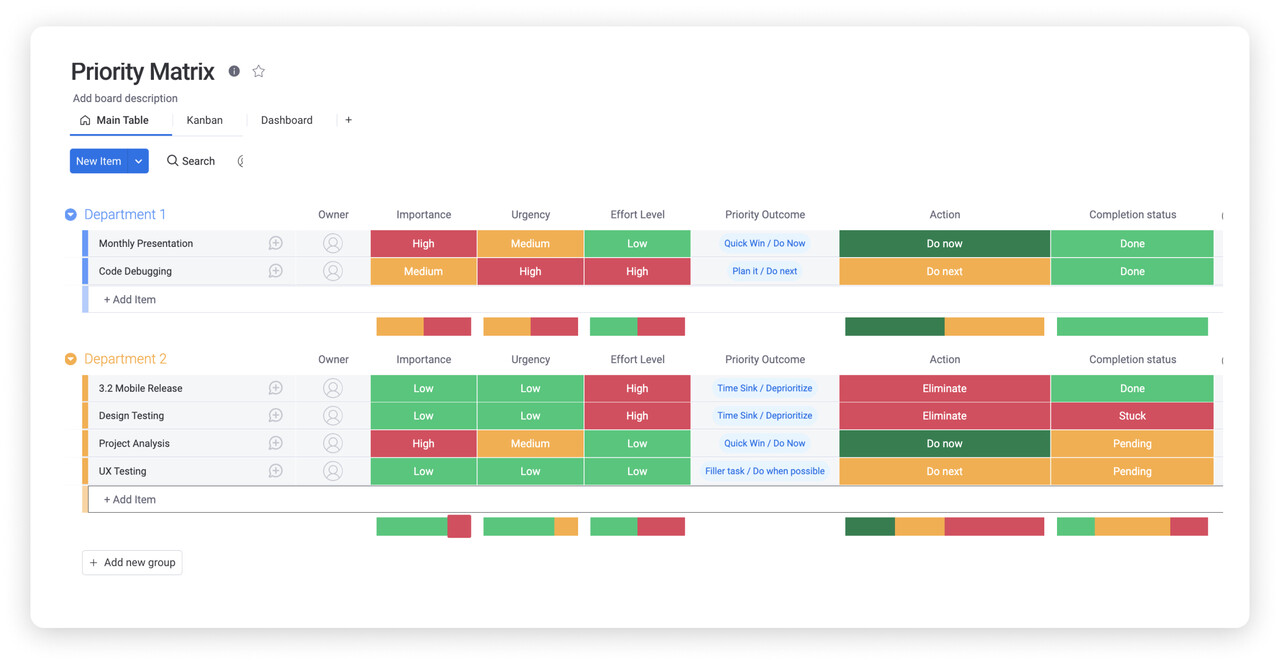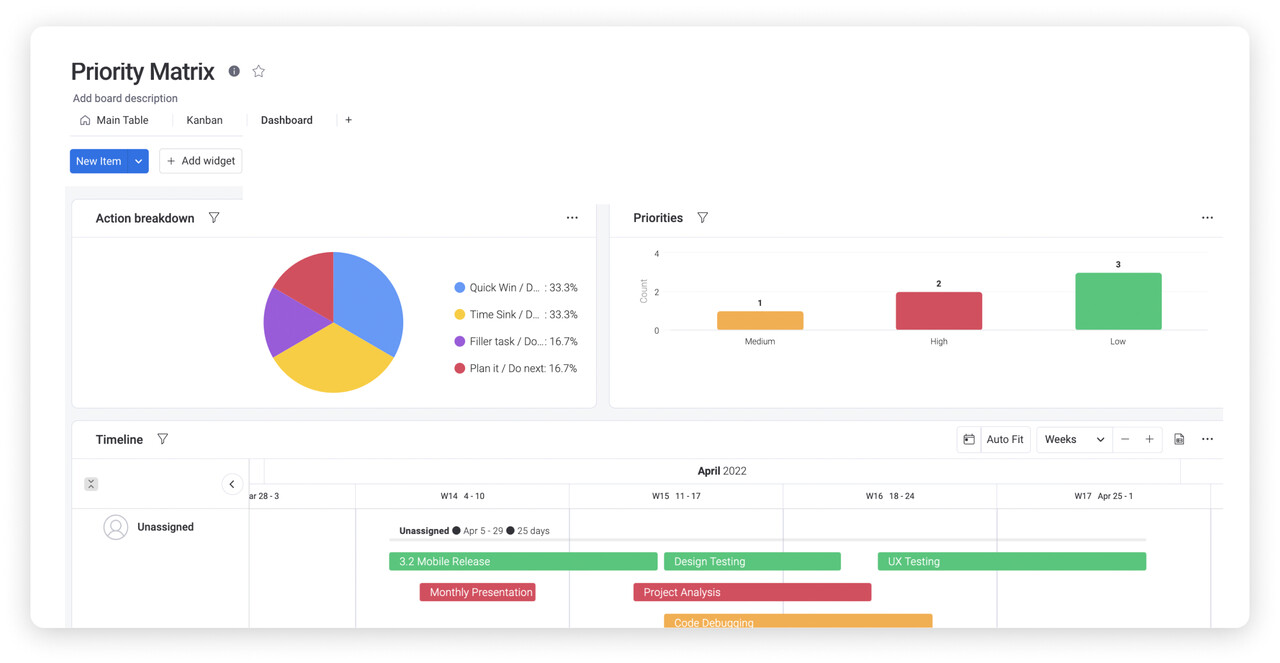We’ve all dealt with busy seasons at work. As tasks accumulate, it can be difficult to decide which ones to do first. A prioritization template lets you organize your projects more efficiently, helping to ensure nothing slips through the cracks.
In this article, you’ll discover how prioritization templates can help you manage your time and complete essential tasks by ranking upcoming projects based on urgency. We’ll also share a customizable prioritization template that you can use to improve your day-to-day productivity.
What is a prioritization template?

A prioritization template is an organizational tool that helps you decide which projects to handle first. To organize your tasks, it considers factors like deadlines, urgency, and level of difficulty. Many templates come in the form of a priority matrix, or a two-dimensional chart that ranks your task in order of importance.
With a high-quality prioritization template, you can better manage your workflow, save time, and improve decision-making.
Let’s take a closer look at some of the unique benefits they offer.
Why use a prioritization template?
Managing multiple projects isn’t easy, especially when you have a lot on your plate. Prioritization templates provide deeper insight into your priorities, allowing you to do your job more efficiently. Key benefits include:
- Enhanced organization
- Better decision-making
- Improved time management
A prioritization template enhances your organization by displaying information that helps you rate projects in order of importance. Instead of focusing solely on chronological order, these ratings account for multiple factors, including timeline, urgency, and difficulty. Not only does this help you understand which tasks need to get done first, it also helps guide decision-making for entire teams.
By ranking your upcoming projects, a prioritization template can show you which tasks you should handle on your own and which tasks you should delegate.Once you’ve set the ratings, you should prioritize tasks that are listed in the template as having high levels of difficulty or urgency, while delegating less important tanks to other employees. If you delegate properly, you can improve both efficiency and time management. A prioritization template can also give insight into which tasks can be eliminated, saving your team even more time. For the best results, you should use a template suited for your team’s needs. Let’s look at a few examples of prioritization templates.
What are some examples of prioritization templates?
While every prioritization template helps organize priorities, they accomplish this in different ways. All templates have their own prioritization frameworks, which is a set of principles that product managers and teams use to rank their priorities. To help ensure your goals are met, it’s important to use a prioritization template aligned with your interests. Here are some examples of commonly-used templates.
Decision-making prioritization template
A decision-making prioritization template is used to determine the order in which tasks are completed. It can also help decide who should complete which tasks, or if the team should eliminate certain tasks. A decision-making prioritization framework may include the following:
- Urgency
- Importance
- Timeline
- Impact
- Effort
You and your team evaluate all of your tasks based on these factors and assigned a timeline. You can also delegate certain employees to the tasks.
Product management prioritization template
A product management prioritization template helps teams decide which product is most desirable. The prioritization framework usually consists of the following:
- Affordability
- Quality
- User experience
- Relevance
- Uniqueness
Businesses often use this template when trying to decide which product to release. It may also be used to compare products you’re interested in buying. When comparing products, you can customize your template to include any factors you’d like by using a project management tool, such as monday.com.
Prioritization templates on monday.com

Better organization helps you make decisions that benefit your team. On monday.com, you’ll find easy-to-use prioritization templates that can be customized to meet your team’s demands. Here are a few of the top features you can enjoy with one of our decision priority matrices:
- Strong customization
- Visual guides
- Flexible Work OS
Our prioritization templates are highly customizable, allowing you to input whichever factors you want to consider for decision-making. For example, you can evaluate impact, effort, and urgency simultaneously. After ranking them based on priority, you can then assign a timeline to each task.
Another highlight of our prioritization templates is their strong visualization capability. In addition to labeling tasks, you can color code them based on importance. You may also organize data in an easy-to-read format, such as in tables or graphs.
Finally, monday.com templates can be easily shared among team members thanks to our flexible Work OS. It allows you to quickly share data across multiple teams, create customized dashboards for every employee, and consolidate data with simple document management. You can also optimize performance by using multiple, related templates at once.
Related templates on monday.com
There are several different templates available that help prioritize tasks. Although you can customize your own template, you can also use an already established priority matrix. Here are some popular templates related to task prioritization.
Eisenhower matrix
The Eisenhower Matrix ranks tasks based on importance and urgency. Each task then falls into a time management category, which dictates when it should be completed. The categories usually consist of the following:
- Do first: These are tasks that rank high in both importance and urgency. They should be at the top of your to-do list.
- Schedule: These are tasks that are high in importance, but low in urgency. They don’t need to be done immediately, but they should be on the schedule.
- Delegate: These are tasks that are high in urgency, but low in importance. Since they need to get done quickly, it may be worth delegating them.
- Avoid: These are tasks that are low in both importance and urgency. If you’re busy, you may want to eliminate these entirely.
The Eisenhower Matrix is a helpful prioritization template for making decisions based on time. It’s commonly used for day-to-day tasks or activities with deadlines.
You may also be interested in: MoSCoW prioritization method explained
Action priority matrix
Like the Eisenhower Matrix, an action priority matrix places tasks into one of four different categories. However, these categories are based on impact and effort. Each task falls into one of the following groups:
- High impact, low effort: These tasks should get done first.
- High impact, high effort: These tasks should be prioritized, but may require more resources first.
- Low impact, low effort: These tasks aren’t hugely important. You may want to delegate them or complete whenever there’s free time.
- Low impact, high effort: These tasks have a low pay-off, but require lots of time and energy. It’s worth considering whether you want to do them.
The Action Priority Matrix is typically used for larger initiatives and business operations.
Work breakdown template
A Work Breakdown Template assists with prioritization by helping you break every project down into smaller tasks. This offers a better understanding of how long the project will take, how many people should be working on it, and which tasks need to get done first. There are two types of work breakdown structures (WBS):
- Functional: A functional WBS revolves around any functional items, such as project management or software engineering.
- Deliverable: A deliverable WBS focuses on the precise deliverables of an individual project.
Frequently asked questions
What does it mean to consider logic when prioritizing tasks?
Considering logic means understanding which tasks must be done before other tasks can be completed. For example, say you have two upcoming assignments: task A and task B. However, you cannot start on task B until task A is finished. By considering logic, task A would be ranked above task B on the prioritization template.
What are the 4 levels of prioritizing tasks?
You can break tasks down into four distinct levels:
- Low
- Medium
- High
- Urgent
Low-ranking tasks can often be eliminated or set to the side, while medium tasks can be delegated. High and urgent tasks should be prioritized by project managers. The names of these levels may vary depending on which priority matrix you’re using.
Improve decision-making with prioritization templates
Prioritization templates help improve efficiency, save time, and dictate decisions by conveniently categorizing your upcoming tasks. They provide a holistic overview of which projects need to be prioritized, when each project should be completed, and who is doing which task.
Of course, every team has its own criteria when it comes to prioritization, which is why it’s helpful to use customizable templates. You can find customizable prioritization templates, as well as pre-made premium and free templates, on monday.com.